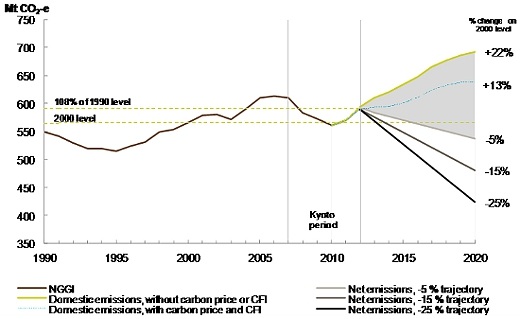A stop-gap policy: why Direct Action falls short
The test for any climate change policy is to ensure it is environmentally effective, economically responsible and socially fair. The Coalition's climate policy fails each of these tests.
The policy was only intended as a stop-gap policy before the 2010 federal election. Three years on it remains full of contradictions, heroic assumptions and unexplained policy measures.
Its three core components are:
-- A capped government fund to support emissions reduction projects;
-- Penalties for businesses exceeding business as usual emissions levels; and
-- Heavy dependence on soil carbon for cheap abatement.
The Coalition claims its policy will reduce Australia’s emissions to at least 5 per cent below 2000 levels by 2020. But the policy bans any international credits or opportunities. Treasury has advised this would double the economic cost of meeting our targets.
The unconditional abatement task requires reducing emissions by around 750 million tonnes cumulatively over the next eight years, so Australia is 155 million tonnes below projected levels in 2020. (See 2012 Projections graph below).

The policy has no ability to scale-up the level of abatement or to reach the target of 80 per cent below 2000 levels by 2050. It doesn't even pretend to be a long-term plan to move to a low emissions future or drive economic transformation.
In 2010, the Department of Climate Change undertook a comprehensive analysis of the policy, concluding it could not deliver its abatement promises, because:
a) If funding was capped, Australia wouldn't meet the unconditional target under a second Kyoto Protocol commitment period (Tony Abbott has repeatedly refused to guarantee the target would be met.)
b) If funding was not capped, the cost to the budget of purchasing 750 million tonnes of abatement would be much higher than forecast (a cost we have estimated at $1,300 for each Australian household).
Emissions Reduction Fund equals an ineffective waste of money
The policy proposes a capped ‘Emissions Reduction Fund’, which is essentially a grant tendering scheme. The Grattan Institute's analysis of grant tendering schemes predicts as much as $100 billion would be required to meet the target.
The Coalition proposes entering contracts with emissions reduction projects by a reverse auction and only making payment when the abatement is delivered. This would completely negate any ability to price discriminate, a fundamental premise of the capped costings.
There would also be the likelihood that consumer prices would rise.
If new gas-fired electricity generation replaced coal-fired generation, for example, why would that change in capacity and fuel costs not increase electricity prices? There is no mechanism for the Coalition to assist low and middle income households with these price impacts, which is why their policy fails the test of social fairness.
A more fundamental problem with the Coalition's proposal is that there is no cap on emissions. A cap is needed to guarantee environmental effectiveness and reach Australia's targets.
Even if genuine reductions could be purchased, emissions would still increase elsewhere in the economy. They could be shifted within a business or around the economy and a project proponent would still pocket taxpayers’ money.
Subsidies for polluters includes a hidden carbon tax
Hoping to avoid this, the Coalition plans to impose penalties on businesses that increase emissions above business as usual levels.
Tony Abbott has spent two years on an over-the-top scare campaign against carbon pricing – all the while his climate action spokesperson, Greg Hunt, is planning a carbon tax on firms increasing their emissions. Does the Coalition’s right hand know what its left hand is doing?
The policy also refers to credits for reductions from business as usual emissions being sold in the Emissions Reduction Fund – an approach similar to the flawed 'baseline and credit' NSW GGAS scheme. Outside a limited number of emission-intensive trade-exposed activities, formulating such baselines would be practically impossible, due to product differentiation in downstream industries and geological differences in upstream extraction activities.
Soil carbon no panacea
The policy places a heavy reliance on soil carbon as a source of cheap abatement to meet Australia's target. It is increasingly clear that such abatement is neither cheap nor plentiful. A recent University of Western Australia study estimated the costs at $80 per tonne of abatement.
Mr Hunt's solution is to water down the Carbon Farming Initiative's environmental integrity and issue more credits, even though these would not represent permanent abatement of carbon.
He wants to store carbon for just 25 years rather than the internationally accepted 100 year benchmark – effectively putting Australia's emissions savings on the credit card for future generations.
Stop gap measures no substitute for long-term action
The policy would create no investment certainty for long-term clean energy investments in assets with lives of 20, 30 or 40 years, and would not allow for deeper cuts to emissions beyond 2020.
The international community is already starting to see through the smokescreen as it increasingly moves towards carbon pricing and serious domestic policy instruments to reduce emissions.
Australia's international standing would be significantly diminished under the Coalition’s plan and we would have no credibility to shape the global agreement due to be negotiated by 2015.
I set out why the world is acting on climate change and how our carbon price is already working during recent speeches in Germany and Sydney.
The Coalition has deliberately left many questions raised about its policy unanswered, because they have no intention of removing the carbon price. They know the government’s emissions trading scheme is the only economically responsible, environmentally effective and socially fair policy for Australia.
Greg Combet has been Australia's climate change minister since September, 2010.
















